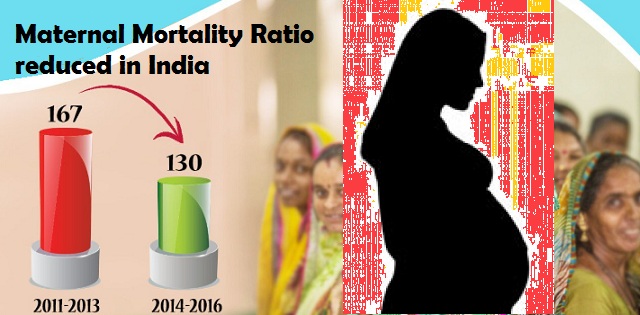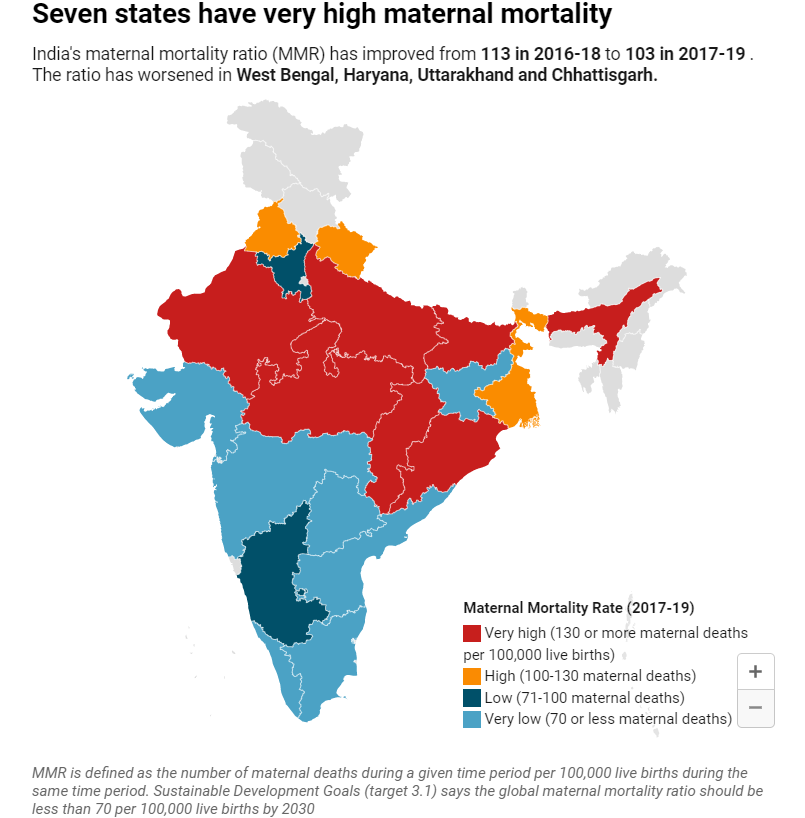Maternal Mortality in India 2017-19.
~Preet.

The Registrar General of India's Sample Registration System (SRS) just published the most recent special bulletin on Maternal Mortality in India (2017-19). According to the World Health Organization, maternal death is defined as the death of a woman while pregnant or within 42 days of a pregnancy termination from any cause connected to or worsened by the pregnancy or its care. The Maternal Mortality Ratio (MMR) is defined as the number of maternal deaths per 100,000 live births within a certain time period.
The Ministry of Home Affairs is in charge of the Registrar General of India. Aside from conducting the Population Census and monitoring the implementation of the Registration of Births and Deaths in the country, it has been providing fertility and mortality estimates using the Sample Registration System (SRS). SRS is the country's biggest demographic sample survey, providing direct estimates of maternal mortality through a nationally representative sample, among other variables. On a regular basis, VA instruments are administered for fatalities reported under the SRS in order to produce a cause-specific mortality profile for the country.
India's MMR has dropped by 10 points. It has decreased from 113 in 2016-18 to 103 in 2017-19. (8.8 percent decline). The MMR in the country has gradually decreased from 130 in 2014-2016 to 122 in 2015-17, 113 in 2016-18, and 103 in 2017-19. India was on the verge of meeting the National Health Policy (NHP) objective of 100/lakh live births by 2020 and was on pace to meet the United Nations Sustainable Development Goals aim of 70/lakh live births by 2030. Many wealthy countries have succeeded in reducing MMR to single digits. The lowest MMR is two in Italy, Norway, Poland, and Belarus, while it is seven in Germany and the United Kingdom, ten in Canada, and 19 in the United States. The majority of India's neighbours have a higher MMR, including Nepal (186), Bangladesh (173), and Pakistan (140). China and Sri Lanka, on the other hand, are far ahead, with MMRs of 18.3 and 36, respectively.

The number of states that have met the SDG target has increased from five to seven, with Kerala (30), Maharashtra (38), Telangana (56), Tamil Nadu (58), Andhra Pradesh (58), Jharkhand (61), and Gujarat among them (70). Kerala has the lowest MMR, which puts it well ahead of the national MMR of 103. The Maternal MMR in Kerala has fallen by 12 points. The most recent SRS report (2015-17) set the state's MMR at 42. (later adjusting it to 43). There are currently nine states that have met the NHP's MMR objective, including the seven mentioned above, as well as Karnataka (83) and Haryana (96). Uttarakhand (101), West Bengal (109), Punjab (114), Bihar (130), Odisha (136), and Rajasthan (141) have MMRs ranging from 100 to 150, whereas Chhattisgarh (160), Madhya Pradesh (163), Uttar Pradesh (167), and Assam (205) have MMRs that exceed 150.
Maternal mortality in a region is a measure of the reproductive health of the region's women. The WHO has already praised India's efforts to reduce maternal mortality. India must pay special attention to states with higher MMR.

The Ministry of Home Affairs is in charge of the Registrar General of India. Aside from conducting the Population Census and monitoring the implementation of the Registration of Births and Deaths in the country, it has been providing fertility and mortality estimates using the Sample Registration System (SRS). SRS is the country's biggest demographic sample survey, providing direct estimates of maternal mortality through a nationally representative sample, among other variables. On a regular basis, VA instruments are administered for fatalities reported under the SRS in order to produce a cause-specific mortality profile for the country.
India's MMR has dropped by 10 points. It has decreased from 113 in 2016-18 to 103 in 2017-19. (8.8 percent decline). The MMR in the country has gradually decreased from 130 in 2014-2016 to 122 in 2015-17, 113 in 2016-18, and 103 in 2017-19. India was on the verge of meeting the National Health Policy (NHP) objective of 100/lakh live births by 2020 and was on pace to meet the United Nations Sustainable Development Goals aim of 70/lakh live births by 2030. Many wealthy countries have succeeded in reducing MMR to single digits. The lowest MMR is two in Italy, Norway, Poland, and Belarus, while it is seven in Germany and the United Kingdom, ten in Canada, and 19 in the United States. The majority of India's neighbours have a higher MMR, including Nepal (186), Bangladesh (173), and Pakistan (140). China and Sri Lanka, on the other hand, are far ahead, with MMRs of 18.3 and 36, respectively.

The number of states that have met the SDG target has increased from five to seven, with Kerala (30), Maharashtra (38), Telangana (56), Tamil Nadu (58), Andhra Pradesh (58), Jharkhand (61), and Gujarat among them (70). Kerala has the lowest MMR, which puts it well ahead of the national MMR of 103. The Maternal MMR in Kerala has fallen by 12 points. The most recent SRS report (2015-17) set the state's MMR at 42. (later adjusting it to 43). There are currently nine states that have met the NHP's MMR objective, including the seven mentioned above, as well as Karnataka (83) and Haryana (96). Uttarakhand (101), West Bengal (109), Punjab (114), Bihar (130), Odisha (136), and Rajasthan (141) have MMRs ranging from 100 to 150, whereas Chhattisgarh (160), Madhya Pradesh (163), Uttar Pradesh (167), and Assam (205) have MMRs that exceed 150.
Maternal mortality in a region is a measure of the reproductive health of the region's women. The WHO has already praised India's efforts to reduce maternal mortality. India must pay special attention to states with higher MMR.
Comments
Post a Comment